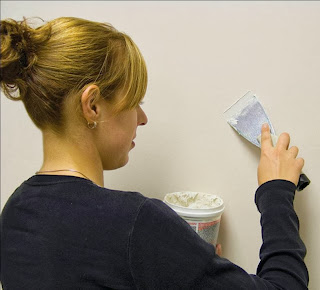|
What
do you need home repair help with? A picture hung, a ceiling fan
installed, or your bathroom remodeled. We are here to help you with all
of your handymen needs. http://orlandoshandyman.com
Come in and chat with us, ask us anything. All Estimates are Free!
Surface Preparation Guide |
| Incomplete
or insufficient preparation is the single greatest cause of paint
failures. All surfaces should be sound, clean and dry before painting.
Use the guidelines below to prepare your surfaces for painting. |
|
|
| STEP 1 |
| Remove dirt, grease, oil and chemicals |
|
Dirt,
grease, oil or chemicals may interfere with the adhesion of paint.
Clean your surface with soap and water, household cleaner or trisodium
phosphate (TSP) solution.
Do not use solvents to clean surfaces.
Solvents tend to smear grease and oil and leave residue on your
surface. Strong solvents can also soften a previous finish and make
your new paint application susceptible to wrinkling. |
|
| STEP 2 |
| Remove loose rust, as well as chipping or peeling paint |
|
Create
a smooth surface before applying your primer and/or base coat.
Painting over loose rust will result in poor adhesion and an uneven
finish.
Remove loose rust or paint by sanding or scraping your
surface with a wire brush, sandpaper, steel wool or a scraper. Sand
glossy surfaces lightly. Do not sand old paint that may contain lead. |
|
| STEP 3 |
| Rinse and let dry |
|
| Rinse your surface and allow it to dry completely before applying a primer or top coat. |
|
| STEP 4 |
| Apply a primer |
|
Priming
is recommended to increase the adhesion of your top coat to your
surface. Priming also provides a thicker film buildup, which increases
durability and creates a flatter and smoother surface for applying your
top coat.
Priming is suggested on these surfaces: |
|
|
| Bare Metal |
| Priming
makes your top coat adhere more smoothly to bare metal. Priming also
adds to the rust-inhibitive function of your coating. |
|
| Bare Wood |
| Bare
wood is a porous substrate that holds air and moisture. Priming is
suggested to ensure a smooth, uniform top coat. Priming will also
prevent bleeding from your wood. Sand off weathered wood and replace
rotten or water-damaged wood before painting. |
|
| Concrete |
| Water-damaged
concrete has a sandy or gritty surface that comes off easily when
rubbed. Remove this loose material by sanding or etching. Prevent
water or moisture from penetrating underneath your paint or peeling will
occur. |
|
| Darkly Painted Surfaces |
| If
you are changing from a dark coat to a light coat, prime in order to
cover your old color completely. Priming also helps prevent bleeding of
your old color through your new top coat. |
|
|
|
| STEP 5 |
| Apply a top coat |
|
|
| Aerosol Application |
| Apply
aerosol paints outdoors or in a well-ventilated area. Spray on smooth,
even coats for a smooth, factory-like finish. Keep your can parallel
to the surface of your object and move your can back and forth. |
|
| Brush Application |
| Apply
brush paints with a high-quality brush or roller. For best control,
hold your brush at the base of your handle (the end closest to the
bristles). |
|
|
|
| STEP 6 |
| Recoat if necessary |
|
| Follow
recoating directions on your can. Apply a second coat of paint if
necessary. Each product dries at a different rate. If you sand
in-between coats, allow the full recoat time to dry before applying
another coat (at recommended drying temperature). |
|
|
|
|
|
|
JOMAX® House Cleaner and Mildew Killer kills mold and mildew instantly while removing tough dirt and stains - without damage to the existing finish, or nearby plants or shrubs. And it’s economical! One gallon of JOMAX makes enough solution to clean a two story house.
PRODUCT FEATURES:
Kills mold & mildew fast!
Cleans off dirt and stains
Easy to use - No scrubbing necessary!
Economical – one gallon makes 20 gallons of cleaning solution
Can be used near plants or shrubs
Reprinted from
http://www.rustoleum.com/CBGResourceCenter.asp?sn=sur
http://orlandoshandyman.com

No comments:
Post a Comment